The giant puffball is one of my favourite mushrooms. I’ve been intrigued by giant puffballs since I first saw a photo of one in a book when I was a child. The mushroom was growing in grass, and I could see its huge size in relation to the grass – it looked to be the size of two footballs, side by side. The book was English, though, and I never expected to see them in New Zealand.
The first time I saw a giant puffball in the flesh was when someone brought one in to the Allan Herbarium near Christchurch. I was working there at the time, and looked after the lab where we pressed all the new plant specimens people brought in. But the giant puffball wasn’t brought in as a specimen. I remember that someone took a bread knife from the drawer of the kitchen beside the lab and carved the puffball up into segments. Then, it was shared out among those who liked eating wild mushrooms.
At that time, I’d never eaten a wild mushroom in my life. I’d read enough about death cap poisoning to know that eating wild mushrooms wasn’t an activity for the uninformed. However, my colleagues were professional botanists1, well-versed in observing the natural world, and a number of them were experienced foragers. I also knew from my own reading that giant puffballs were edible as long as they were completely white inside, and virtually unmistakable. There really aren’t any other mushrooms which look anything like them.
I took home a wedge of the football-sized mushroom, sliced it and fried it in butter and garlic, as my colleagues recommended. It was delicious, although all I could actually taste was the butter and garlic. What I enjoyed most was the idea of it. Collecting and eating wild foods is something that sustained us for most of our history. Even when we turned to agriculture, a mere 10,000 years ago, it’s unlikely that we spurned wild foods. Most people would have known the plants, animals and fungi around them, and would partake of the wild bounty if it presented itself.
It was some years later, when I was working in Wellington, that I learned one of my friends had giant puffballs growing in her paddocks. When she found out I liked to eat them, she’d bring them to work for me. I used to slice them up, layer them with cheese and chutney, and cook them in the toasted sandwich maker at lunchtime. Then, I’d offer my colleagues puffball toasted sandwiches.
I remember a wide range of reactions to the offer of this unusual lunch. Some people were keen, or at least curious. Some were more suspicious but gave it a try and were pleasantly surprised. A few seemed convinced that I risked poisoning myself and half of the office.
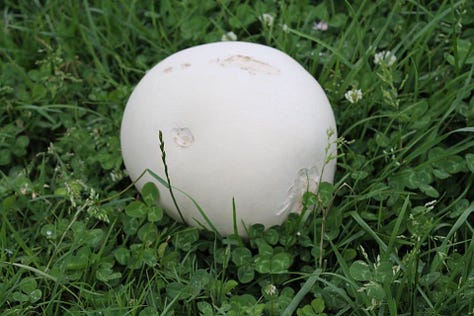
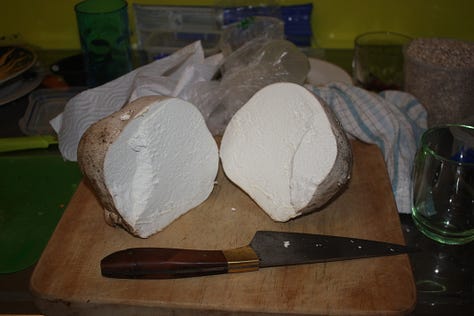

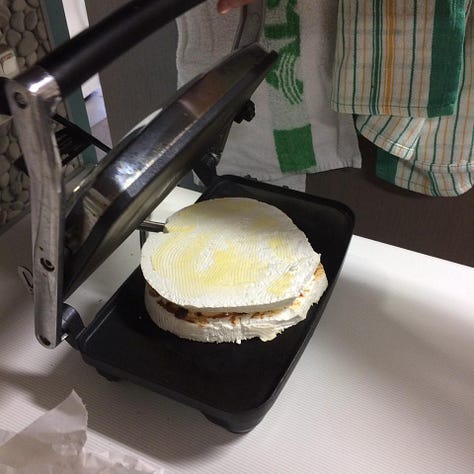

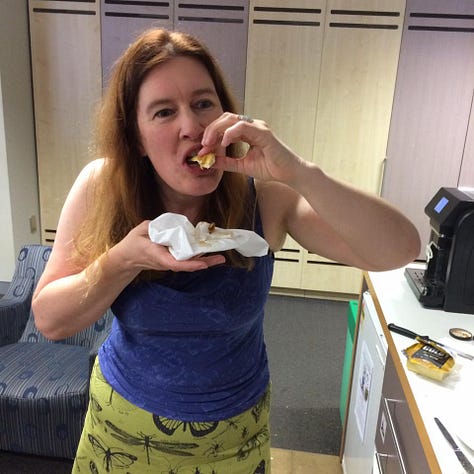
I definitely wasn’t going to poison my colleagues. I was confident in both the edibility of giant puffballs and in my ability to identify them. But I do concede one point – I certainly wouldn’t want to be offering people a wild mushroom, or a wild plant for that matter, if I wasn’t completely certain it was something edible.
Most of us don’t need to supplement our diet with wild food, but it can offer us something we wouldn’t otherwise have. One of my favourite foraging moments came when I was walking in Bothamley Park, a large, streamside reserve which runs through one of the more deprived parts of Wellington. In one part of the park, I came across a huge patch of blackberry, covered in vicious spines and perfectly ripe fruit. Blackberry always makes you work for your harvest, but to make things easier, someone had cut tracks which criss-crossed the tangle of thorny stems. These tracks wouldn’t have been easy to create – it would have taken skill and a chainsaw or scrubcutter – so it was likely a contractor working for the local council. There were dozens of people in the blackberry patch, mostly families, harvesting containers of blackberries.
Commercially-grown blackberries, if they are sold fresh, are always expensive, because they are difficult to harvest and don’t store well. Blackberry is also a serious invasive weed, affecting both agriculture and native forest regeneration. But it’s so widespread and abundant that it simply cannot be controlled everywhere. When I saw it, I thought that turning an area of dense blackberry into a community foraging area was a good, pragmatic decision. It was lovely to see so many people able to enjoy the free harvest from an invasive weed.
In New Zealand, many good species to forage are weeds. Some of the good mushrooms such as the giant puffball and the porcini are also introduced and grow well here. It means that there are plants and mushrooms we can enjoy without being concerned that harvesting them is a threat. This isn’t the case with everything, though, and it isn’t the case everywhere. There are also restrictions on taking plants and fungi from some areas, and there are places which might be too dirty or polluted to take food from.
But when it comes to safety, the first, and most important, rule of wild food foraging is that you must be absolutely certain of your identification before eating something. But this isn’t a failsafe rule. After all, we’ve all seen people be confidently wrong.
I’ve been wrong when trying to identify plants and mushrooms many times – after all, making mistakes is part of learning. But I find out that I’ve made a mistake when someone corrects me, or I read more information in a book or online. I don’t want to learn by making myself or someone else sick.
Learning to identify something isn’t only about figuring out what it is. Part of the process is figuring out what it isn’t. This may be the most crucial part of learning to forage. It isn’t enough to be able to recognise an edible plant or mushroom. It’s essential to know how to recognise the ones that are dangerous, particularly the ones which look similar to edible species.
The best illustration I can give of this is an example from a colleague, a botanist, who shall remain nameless. One Monday, he showed me one of the morels he had found on the weekend. Morels are a sought-after wild mushroom, growing around the world, including New Zealand, where we have one native species and at least one introduced. He and his wife had been delighted to find them. They’d cooked and eaten the morels over the weekend, but had saved the one I was shown.
It wasn’t a morel. It was a kind of mushroom commonly known as a false morel. The two kinds of mushroom aren’t closely related, but they have some superficial similarities. People do sometimes confuse them, hence the name. But while morels are edible, false morels aren’t, not unless you like high-stakes gambling.
My beautiful Italian mushroom book sums up the problem: false morels, considered by many to be an edible mushroom and therefore consumed, can sometimes be deadly. Some, but not all, species of false morel contain dangerous toxins which are volatile, meaning they usually evaporate when the mushroom is cooked. Usually. One book I read many years ago indicated that cooking with a pot lid on instead of leaving the lid off could be enough to prevent the toxins escaping. People can become sensitised over time, so that they can be poisoned after a meal despite eating the mushrooms without ill-effect in the past. The mushrooms themselves vary in how toxic they are, and people vary in their sensitivity too. Fatalities are rare, but in the parts of Europe where eating these mushrooms is traditional, they do occur. And even non-fatal poisonings can leave people severely ill for some time.
My colleague and his wife were fine, but they were lucky. While people do eat false morels and come to no harm, they aren’t the kind of mushroom you’d want to eat unknowingly.
If someone only knows what a morel looks like, and doesn’t know that false morels exist, it isn’t hard to mix them up. But if you know what a false morel looks like, and which features distinguish it from a true morel, it’s very hard to make a mistake. As an analogy, imagine someone who is familiar with horses. They’ve seen Shetland ponies, Arabians and mighty Clydesdales, jet-black Friesians, golden Haflingers and spotted Appaloosas. If, somehow, they’d never heard of zebras, on encountering one they might assume they were seeing another variation of horse. But if they know that horses aren’t striped and zebras are, it would be impossible for them to be confused.

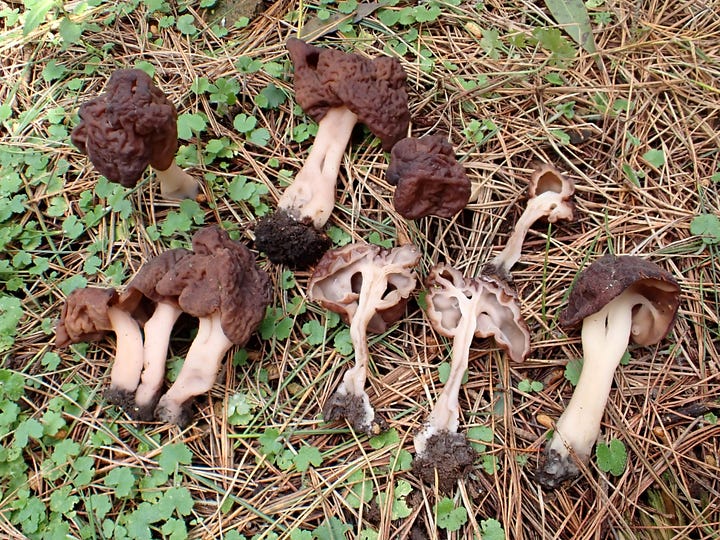
Every edible mushroom or plant has look-alikes – species with which they can be confused. Sometimes the lookalikes are related, such as the edible amanitas and death caps, or field mushrooms and yellow-staining mushrooms. This can be the case with plants as well, for example, wild carrots are related to the deadly hemlock. Sometimes lookalikes are unrelated but have a superficial resemblance, like morels and false morels, or small puffballs and immature amanitas. A few years ago a forager nearly died when he mistook deadly tutu for the edible shoots of the vine supplejack. While tutu and supplejack are very different plants, and unrelated, the new shoots do show some similar features.
It isn’t important whether the lookalikes are related or not, though. There are two things which matter about lookalikes – how easy they are to distinguish from edible species, and how dangerous they are if you make a mistake.
This is where I find my experience in risk assessment helps me. There are many different ways to assess risk, but one basic approach is to identify a hazard, work out how likely it is to cause harm (the likelihood) and how bad it would be if it did (the consequences)2. It’s also useful to consider how certain the likelihood and consequences are.
This way of looking at risk can be applied to foraging and lookalikes. Lookalikes are a hazard. They can look more or less similar to an edible species (which affects the likelihood of an error), and they can be more or less dangerous if you eat them (the consequences). Some, too, have more uncertainty than others. There’s a lot of uncertainty about false morels, due to levels of toxin, individual susceptibility and cooking. There's much less uncertainty with something like a death cap or tutu.
In the case of morels and false morels, it’s not easy to confuse them if you are aware of false morels and the features which distinguish them from morels. In the case of my giant puffball, there really isn’t anything else which resembles it. Small puffballs can be confused with the toxic earthballs and with immature amanitas – and I’ve seen people make these mistakes – but there are simple ways to distinguish them. The main concern with giant puffballs is the condition they are in. When they are pure white inside, they are edible, but as they get older, they begin to turn a yellowish-brown. Once there’s any hint of colour, they shouldn’t be eaten.
But there are other groups which require much more skill and experience. The amanita mushrooms, which do include some highly-prized edible species, are one such group. I’m content to avoid anything which remotely resembles this group and eat a limited range of easily identified mushrooms which can be easily distinguished from their lookalikes. Another group which can be difficult for non-expert is the botanical family that the carrot belongs to. The carrot has a number of wild relatives which aren’t easy to distinguish. Every region has a different range of these species, making local knowledge essential.
Mistakes in identification, however, aren’t all equally dangerous – this is where the consequences part of the risk assessment fits in. The closest toxic lookalike to the field mushroom is the yellow-staining mushroom. This can cause an unpleasant gastric illness, but it’s not deadly. There are also various kinds of wild brassica – cousins to cabbage, broccoli and radish. While some contain toxins, it’s very unlikely that someone would eat enough to come to harm. In fact, there are a number of plant groups in New Zealand where no member of the group is likely to cause poisoning. Another example in New Zealand is the coffee family, to which our native coprosma shrubs belong. If you can reliably identify a plant as belonging to one of those groups, then mistaking one species for another isn’t dangerous.
But with other groups, errors can be fatal. I’ve already mentioned false morels, and have written previously about death caps and tutu. But many people aren’t aware how dangerous the carrot family is for foragers.
We eat a number of vegetables and herbs from the carrot family, including parsnips, celery, parsley, fennel and coriander. Although these vegetables and herbs are very different from one another, they have the same manner of growing and type of flower, and they are obvious once you know them. But these same features are shared by some dangerous plants indeed. Even though I have a lot of confidence in my botanical skills, this isn’t a group I forage for.
In Europe, there’s a deadly trio – hemlock, water hemlock and hemlock water dropwort. All three are common, and look dangerously similar to edible species such as wild carrot, cow parsley and common hogweed. North America has a different combination of deadly species, but also has dangerous plants in this group. In Asia, there’s a widely eaten vegetable closely related to hemlock water dropwort. In Australia and New Zealand, we have hemlock, and a couple of non-toxic relatives of hemlock water dropwort, but not the other dangerous species.
The identification skills to forage safely can’t be acquired overnight. Apps which identify plants and fungi can be a useful tool for learning, but they also make lethal errors. They can’t be trusted to identify edible plants safely. Books only show a few images, and can’t show the full range of variation you might see in a species. Even experts have blind spots, so it’s good to learn from different people. But foraging can be fun, and delicious, for those who develop the skills. It can bring us a greater connection with the natural world, and an appreciation of the skills our ancestors once had.
Mushrooms aren’t plants, and botanists don’t necessarily know how to identify fungi, but the skills do overlap – with some exceptions as I’ll get to.
There are many ways to describe risk and this is only one, but it works for foraging.





I love giant puff balls, as you say, a way of eating garlic and butter.just read “the forbidden garden of Leningrad” they ate everything during the siege. Recommended
Thanks for all that but I'm still in the dark as to how to identify poisonous mushrooms. I will have to stick with the supermarket varieties